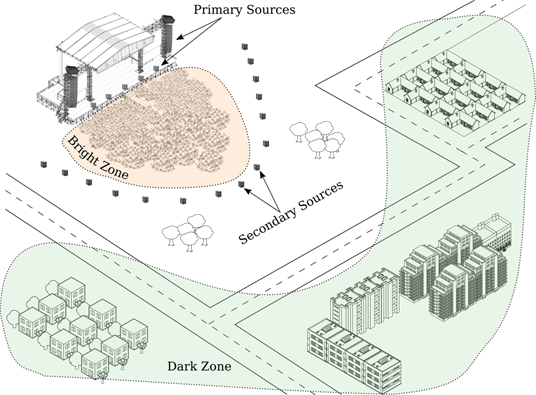Organisers of concerts want to give their performers and audiences the best music experience but they also wish to comply with local regulations on environmental sound exposure.
This produces a two-sided dilemma when you talk about outdoor concerts in residential areas: Since high sound pressure levels are necessary for optimal concert sound, there is a risk of the audience becoming disappointed and artists turning down invitations to perform if regulations say you have to turn down the volume.
And even if you comply with the regulations, you might still have to deal with residents living next to the venue who complain about the noise coming from the concerts, and that it is affecting their quality of life.
Deploying sound zones at outdoor venues
To help solve these challenges, MONICA deploys an acoustic system with sound zones at the venue. The system consists of novel sound field control schemes which provide an optimised sound field in the audience area (bright zone) while minimising the exposure to noise in neighboring areas (dark zones). Thus, at the front of the stage, the music can be louder for a better concert experience, whereas sound level is reduced outside the concert area and in a selection of quiet zones. The sound levels are automatically controlled by the system, adjusting for changes in weather or audiences.
Additionally, information about the sound levels is displayed and used for different purposes, i.e. moving to a quieter zone, checking that regulations are kept, studying health aspects etc.
How does it work?
The acoustic system can be divided into three main parts: Sound Field Control System, Quiet Zones and Monitoring.
Sound Field Control System
Based on an array of loudspeakers and integration with the existing sound system at the venue, MONICA deploys an Adaptive Sound Field Control System (ASFCS), using the concept of sound zones. The sound zone in front of the stage has an optimised sound field whereas the sound level outside the zone is reduced.
To accommodate for the variable weather conditions i.e. wind, temperature and humidity, which add complexity to the propagation of sound, the MONICA ASFCS has an adaptive model updating system that adjusts for changes in climate and audience configuration.
The data used for updating the propagation model come from various IoT-enabled devices at the venue such as microphones, wind and temperature sensors and video cameras. The IoT devices are integrated with the ASFCS using the MONICA cloud platform. As a result, the system can continually update the sound propagation model and the loudspeaker signals, using the data from the devices.
See MONICA publication: An Adaptive, Data-Driven Sound Field Control Strategy for Outdoor Concerts
Quiet Zones
In addition to the ASFCS, a Quiet Zone system provides local quiet zones within and close to the loud event area. These quiet zones can be used by staff and the public for any need.
Monitoring
For awareness purposes, IoT sound level meters are used to measure sound levels at strategic locations and send the information to organisers, public services, the audience and the neighbourhood. Other IoT enabled devices such as smartphones and wristbands can also be used to measure non-calibrated sound levels.
First applications ready
In May 2018, the first large, outdoor test of the system was completed with good results, achieving a 10 dB reduction behind the audience. Read more about the results HERE
The first demonstration of the sound control system at a real music event takes place at the Kappa FuturFestival on 7th and 8th July, 2018.





